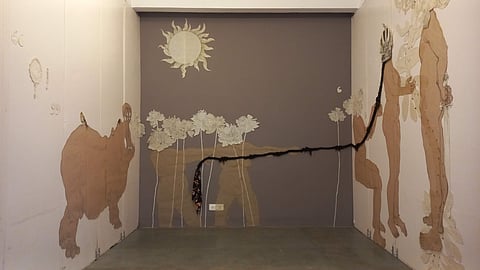
- LIFESTYLE
- FASHION
- FOOD
- ENTERTAINMENT
- EVENTS
- CULTURE
- VIDEOS
- WEB STORIES
- GALLERIES
- GADGETS
- CAR & BIKE
- SOCIETY
- TRAVEL
- NORTH EAST
- INDULGE CONNECT

In an ever-changing world, memory often clings to residue — what is left behind, unspoken, or nearly lost.
Athai Joham’s work, Scars of Cultivation, is a visceral meditation on jhum cultivation — a traditional agricultural method rooted in her hometown, Longding district, Arunachal Pradesh. Her use of locally sourced rice, corn, beans, and millet is based on how it is inherited, a “pulse of sustenance.”
“The burning of forests leaves behind raw, visceral patterns like scars etched into the skin of the earth,” Athai explains. “These traces are not merely signs of damage, but also of survival and rebirth.” Her process extends to burning the fabric after completing the art installation which mirrors nature’s way of destroying and regenerating land.
“My parents are farmers. I come from that background, and my work is deeply connected with cultivation and agriculture,” she says. Through natural materials and memory, Athai blurs the boundary between her practice and her past.
Kolkata-based artist Deepanwita Das turns the city’s colonial past into a framework for floral documentation. Her practice draws from wild roadside flora and the ornamental details of neoclassical architecture, specifically from heritage buildings like Jora Sanko Thakurbari.
“These are the same floras,” she observes, “but they have different meanings now because of different purposes. I started merging the past and present so it could act like an amalgamation.”
In one installation, a sculptural form is lit to cast a shadow onto a drawing which evokes both memory and haunting. “The shadow is like a ghost of the past,” she says. “When viewers walk through the space, their shadow becomes part of the work. It’s not direct, but we’re all affected.”
Working in printmaking, Deepanwita repurposes copper plates, wood blocks, and natural fibres like jute. “I’m now incorporating Meenakari inks too,” she says, to reflect the ornate quality of colonial floral embellishments. For her, residue is found in the systems of documentation and aesthetics left behind by colonisers — still embedded in what we see, plant, and print today.
For Harun Al Rashid, residue lives in memory — fragmented, scattered, and deeply intimate. His work revisits his childhood home, once rural, now transformed by rapid urbanisation.
“When I returned, the entire cartography of the area had changed,” he recalls. “You can’t remember everything, only through fragments.” Rashid uses damaged pages from his late grandfather’s book collection as both material and metaphor. “He was a scholar. His books were decaying. I collected them, and now I recreate a poetic language out of these ruins,” he says.
The usage of his grandfather’s belongings, the books he touched is central to Rashid’s practice. “Those materials have their own voice. I don’t have to force anything. It’s already there.” Together, these artists transform residues into powerful gestures of revival. Whether through fields burned and replanted, colonial shadows turned floral ghosts, or books reborn as memory maps, Speaking of Residues is an exhibition about what endures, and how we choose to carry it forward.
Free entry.
On till June 20, 11 am to 7 pm.
At Dhi Contemporary, Madhapur.
Email: anshula.u@newindianexpress.com
X: @ indulgexpress